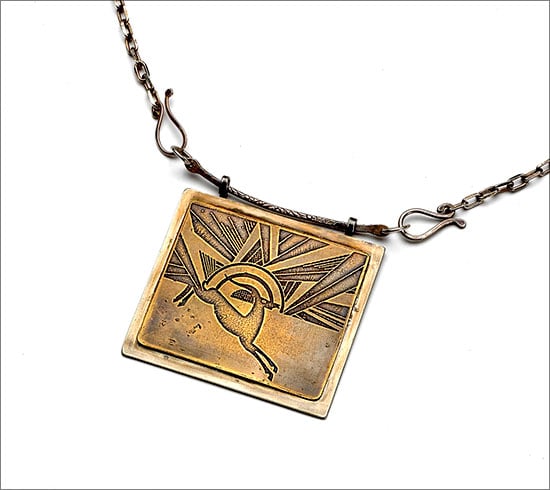Easy Etching Step by Step
This technique involves the transfer of an image to metal using a material that will "resist" the dissolving action of acid. Where you apply a resist the metal will be protected; everywhere else, the acid (ferric chloride) will etch the metal, resulting in a raised image or pattern. To illustrate the etching technique, one of the more versatile resists, a type of blue acetate film known as PnP ("press 'n' peel") paper, will be used. One side of this paper is shiny and the other is matte. It is the matte side that is used to transfer a pattern onto the metal. The pattern will transfer as a mirror image, so if the direction of the pattern is important or includes lettering, it may be necessary to copy the pattern to clear acetate first and flip it so that it will be reversed on the PnP paper.
6 Minute Read
Easy Etching Step by Step - This technique involves the transfer of an image to metal using a material that will "resist" the dissolving action of acid. Where you apply a resist the metal will be protected; everywhere else, the acid (ferric chloride) will etch the metal, resulting in a raised image or pattern. To illustrate the etching technique, one of the more versatile resists, a type of blue acetate film known as PnP ("press 'n' peel") paper, will be used. One side of this paper is shiny and the other is matte. It is the matte side that is used to transfer a pattern onto the metal. The pattern will transfer as a mirror image, so if the direction of the pattern is important or includes lettering, it may be necessary to copy the pattern to clear acetate first and flip it so that it will be reversed on the PnP paper.
A variety of other materials can be used as resists — even a black permanent marker can be used to draw original art directly on the metal. Rubber stamps using permanent ink, press-on letters, and lace stickers from craft supply stores will all work as resists. More traditional resists include lacquer, shellac, nail polish, rubber cement, asphaltum, electrical tape, contact paper, and paint. The creative applications are almost limitless.
Materials
- Brass, copper, or nickel for etching in 18, 20, or 22 gauge
- Ferric chloride
- PnP paper
Tools & Supplies[/su_spacer]
- Metal shear
- Jeweler's saw
- Scouring pads
- Sandpaper
- Laser printer or carbon-based toner photocopier
- Alcohol
- Iron
- Heat-resistant surface
- Black permanent marker
- Nail polish
- Contact paper
- Styrofoam, 1-in. thick
- Double-sided tape
- Safety glasses
- Dust mask
- Nitrile gloves
- Apron
- Glass dish or disposable plastic container, minimum 6 in. (15.2cm) square
- Baking soda
- Acetate
- Brass brush (optional)
Etching Tips
Wear an apron and eye protection when working with acids. Use nitrile gloves or plastic tongs to lift the metal out of the acid-filled container. To reduce your risk of an acid spill, do not repeatedly check the progress of the etching. Etch small test panels using a timer to know how long to leave the metal in the acid to achieve the depth of etching you desire. Rubber cement will stand up to the ferric chloride solution for 5 hours, PnP paper for over 2 hours, but felt tip permanent marker begins to break down after an hour and a half. A batch of ferric chloride is usually good for 5 hours-worth of etching; after that, the etching process dramatically slows.
Safety Notes: Do not allow the ferric chloride to touch your skin or your eyes. Do not touch your eyes with your fingers if you have been handling ferric chloride. Do not inhale any vapors that may be given off by the ferric chloride. If skin or eye exposure occurs, rinse with water for 15 minutes and seek immediate medical attention. When you have used up a bottle of ferric chloride, take it to the nearest official hazardous waste disposal site.
Ferric chloride will stain everything it touches. Be sure to cover your work area with several layers of newspaper to protect the surface from staining. Wear an apron to protect your clothes. If you rinse the ferric chloride into a sink, scrub the sink afterward with abrasive powder to remove any stains and residue.
The following is a link to the Household Products Database on the Web site maintained by the National Institutes of Health, describing the properties and hazards of ferric chloride. Read the information on the health effects of ferric chloride thoroughly before undertaking any etching project using ferric chloride.
You assume all responsibility and risk for the use of the safety resources available on or through this web page. The International Gem Society LLC does not assume any liability for the materials, information and opinions provided on, or available through, this web page. No advice or information provided by this website shall create any warranty. Reliance on such advice, information or the content of this web page is solely at your own risk, including without limitation any safety guidelines, resources or precautions, or any other information related to safety that may be available on or through this web page. The International Gem Society LLC disclaims any liability for injury, death or damages resulting from the use thereof.
The All-In-One Jewelry Making Solution At Your Fingertips
When you join the Ganoksin community, you get the tools you need to take your work to the next level.
Trusted Jewelry Making Information & Techniques
Sign up to receive the latest articles, techniques, and inspirations with our free newsletter.
